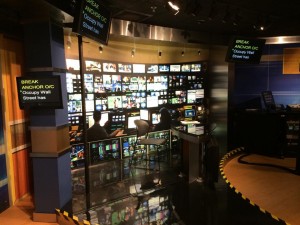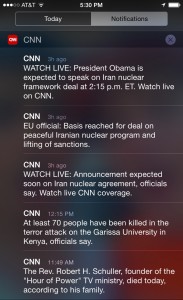By DOMENICA A. LEONE
One place certainly every aspiring journalist should visit is Atlanta. The capital of, and the most populous city, in Georgia is home to massive media operations and newsrooms power houses recognized worldwide.
It was in this city were the legendary Ted Turner would begin the Turner Broadcasting System and establish the headquarters of the infamous “Cable News Network”; better recognized today by the simple acronym of CNN .
These days, the CNN Center is adjacent to the Centennial Olympic Park in downtown Atlanta and is open to anyone who is down for a taste of what real world journalists undergo on a day-to-day basis. It allows visitors to get a feel for what goes on behind the scenes during news gathering and broadcasting as well as an insight into the various CNN networks. Notably, the center is responsible for instructing the ordinary citizen on how dignifying the world of news coverage and reporting can be.

CNN center: home to the world’s largest freestanding escalator
Along the approximately 55-minute guided walking tour; one is able to peek into the newsroom, control room, studios and headquarters main hallways.
The tour begins on a long ride up the world’s largest freestanding escalator as recognized by Guinness World Records. The 196-feet long and eight stories high escalator used to take visitors up to “The World of Sid and Marty Krofft,” an indoor amusement park, but is now CNN’s main newsroom.
You’ll find a replica of a CNN newsroom studio set when landing on the base after that long flight up. While you are waiting for the tour to begin, you’ll be able to videotape or photograph yourself broadcasting breaking news stories as an anchor.
As the tour begins, you’ll access a control room replica of the headquarters’ cable-TV news service, which is actually located on the same spot three stories below. Guests are instructed on the main concepts and activities that take place under this technical hub, allowing them to experience the behind-the-scenes elements of a news broadcast.
 Next, you’ll visit one of the many CNN spin-off cable news channel studios, HLN’s (“Headline News”) Studio 7E.
Next, you’ll visit one of the many CNN spin-off cable news channel studios, HLN’s (“Headline News”) Studio 7E.
This special-effects studio demonstrates visitors the technology that goes into the production of news. For example, the use of a teleprompter, on-air graphics with the aid of a green screen and high-tech touch screen are explained.
Although the tour will involve traveling down many levels of stairs, the following station is totally worthy to get to. A glass-wall on the building’s main hallway will allow you to catch a panoramic view of the main CNN studio, Studio 7. Actually, this is the largest studio CNN has ever built anywhere in the world and, if you are lucky enough you might even catch someone working on air.
 After touring the on-camera presence sites you’ll be redirected to the equivalent of a “chem-lab” for a journalist; the newsroom.
After touring the on-camera presence sites you’ll be redirected to the equivalent of a “chem-lab” for a journalist; the newsroom.
Here you are able to take a bird’s-eye view of both the main CNN and HNL newsroom as people downstairs are on working-mode. This is actually were the magic happens, because it is here were writers compose the news scripts after long processes of gathering and verifying information. In other words they are the responsible for the accuracy and relevance of the facts that households will eventually receive.
Exiting through another of the building hallways you will soon find yourself in front of other of the CNN en Espanol and HNL’s studios were, again if lucky, you might be able to catch an anchor and support crew on duty.
Soon after, you are dismissed, but not after being thanked for your visit. Of course, then you are redirected to the souvenir store where you are able to find amazing merchandise all encrypted on one way or another with the iconic reddish acronym.
Although such tour might sound as fun, it is really just the simplest of the bunch the place has to offer. If you prefer a more extensive (and therefore expensive) VIP tour, you would actually get the chance to step out onto the main CNN newsroom floor and explore production areas that are not normally accessible to the public.
There’s also the possibility for you to go behind the scenes of HLN’s popular morning show, “Morning Express with Robin Meade” on another of the packages.
 No matter your choice, visiting this news landmark will definitely add to your knowledge and experience.
No matter your choice, visiting this news landmark will definitely add to your knowledge and experience.
If you are not news savvy, you’ll learn the basics and, if an aspiring journalist, it will complement your understandings and light a beacon of persistence and perseverance to get a job on the spot (because it sure did in me!).
Getting to go inside Atlanta’s CNN headquarters is certainly an once-in-a-lifetime opportunity. Not to mention a game changer.


 Most news sources have apps for our smartphones, and many offer the helpful “push notifications.” This allows people to receive breaking news updates directly on the home screen of their phone and thus saves people tons of time.
Most news sources have apps for our smartphones, and many offer the helpful “push notifications.” This allows people to receive breaking news updates directly on the home screen of their phone and thus saves people tons of time.




